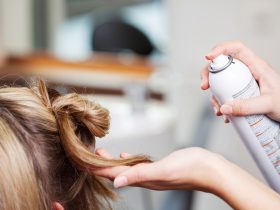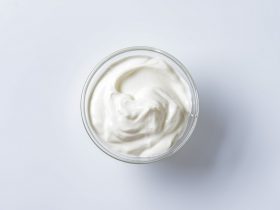Women should not neglect their hair care just because they got pregnant. However, the inadvertent use of toxic chemical ingredients, as well as the possible subsequent harm it can cause an unborn child, can be fearsome and prevent many pregnant women from trying out safer hair products.
Most hair products, including hair dyes, shampoo, conditioner, hair spray and gel, are considered safe to use during pregnancy, especially when applied after the first trimester. Even so, it would be best if fewer chemicals are used as much as possible to further reduce any harm to the developing baby. Keratin hair treatments and some medicated shampoos, on the other hand, should be avoided for the duration of one’s pregnancy.
Jesmarie Macapagal, RN, MD, DPPS
In this article, we will discuss the normal hair cycle and the hair changes that happen when women become pregnant. Next, we will explain what endocrine disruptors are and what harm these chemicals can lead to with maternal exposure during pregnancy. Lastly, we will focus on which hair products are considered safe and which are not safe to use by pregnant women.
Normal Hair Cycle
There are four major phases in the cycle of hair growth (Plikus & Chuong, 2008):
- Anagen – stage of active proliferation
- Catagen – period of cessation of growth and regression
- Telogen – stage of relative inactivity
- Exogen – event of shedding of old hair fiber
During the anagen phase, hair progenitors proliferate (Wang et al., 2017). It is the period of active growth that determines the length of the hair. Each hair follicle is in its own phase of the cycle at any given time, but most will be in the anagen phase in the normal hair cycle (Martinez-Velasco et al., 2017).
Upon entering the catagen phase, the hair follicle shrinks and detaches from the dermal papilla (Martinez-Velasco et al., 2017). Widespread apoptosis during catagen leads to a telogen state (Wang et al., 2017).
The telogen phase follows, when the hair rests, and hair is eventually shed during the exogen phase. Some literature states a fifth phase, the kenogen phase, which is “the period in which the hair follicle remains empty after the telogen hair has been shed and before a new anagen hair emerges” (Martinez-Velasco et al., 2017).
Hair Changes During Pregnancy
Hair appears to become thicker during pregnancy (Motosko et al., 2017). It is not an overstatement that women get to have shinier, healthier-looking, and more voluminous hair when they get pregnant.
The main hormones involved in this phenomenon are estrogen, progesterone, prolactin, and growth factors. High levels of these hormones increase hair growth, the hair diameter, as well as the anagen to telogen ratio (Grymowicz et al., 2020).
Studies have shown that during pregnancy, an increased diameter of the hair shaft can be observed (Tosti et al., 2009). Also, some of the hair follicles stay in the anagen phase of the hair cycle longer than usual because of hormonal changes for the duration of a woman’s pregnancy, resulting in apparent hair thickening (Gizlenti & Ekmekci, 2014).
Endocrine-Disrupting Chemicals (EDCs)
The World Health Organization (WHO) defines an EDC as “an exogenous substance or mixture that alters function(s) of the endocrine system and consequently causes adverse health effects in an intact organism, or its progeny, or (sub)populations” (Haraux et al., 2017).
Also called “endocrine disruptors,” these can be commonly found in personal care products, such as hair products, which result in prenatal exposure through skin absorption and inhalation. The EDCs identified among different hair products, including hot oil treatment, anti-frizz or polish, leave-on conditioner, root stimulator, hair lotion and relaxer, were found to contain cyclosiloxanes, parabens, diethyl phthalate (DEP), nonylphenols, and fragrances, among others (Helm et al., 2018).
Personal care products that contain EDCs are able to cross the placenta (Ghazarian et al., 2018). At present, it is now known that fetuses can be very sensitive to exposure to these compounds (Skakkebaek et al., 2011).
Hypospadias
Hair cosmetics, including hair spray and hair coloring shampoo, are examples of EDCs. EDCs are considered as an environmental risk factor that could lead to congenital syndromes or malformations in the offspring of exposed pregnant women (Haraux et al., 2017).
One example is hypospadias. It is one of the most common congenital anomalies in the urogenital region of infant boys (Ormond et al., 2009). Insufficient virilization of the genital tubercle in hypospadias can result in impaired urinary and sexual functions in males (Haraux et al., 2017).
In 2009, Ormond et al. demonstrated in a case-control study that occupational exposures to hair spray may be a risk factor in the development of hypospadias.
Preterm Birth
Prenatal exposure to EDCs is also associated with higher risk of preterm birth. In a study by Preston et al. in 2021, results showed that frequent use of hair oils by pregnant women was associated with lower age of gestation at birth.
In 2005, Rosenberg et al. also investigated the effect of using hair relaxers during pregnancy in another case control study. However, among more than five thousand African-American women who joined the study, no association with preterm birth was found with the use of hair relaxers prenatally.
Leukemia
Intrauterine exposure to carcinogenic ingredients during pregnancy is known to be harmful for the fetus during its critical window of development (Wiemels, 2012). Some hair dyes have ingredients that have been reported to be carcinogenic (Zhang et al., 2012).
In 2010, Mazzet et al. showed that homemade hair straightening creams with high formaldehyde content were found to be mutagenic. Other compounds in hair dyes that were recognized as human carcinogens include paraphenylenediamine (PPD) (Gago-Dominguez et al., 2003) and 4-aminobiphenyl (4–ABP) (Turesky et al., 2003). Persulphates and paraben esters can also act as EDCs (Couto et al., 2013).
Couto et al. in 2013 completed a multicenter case-control study and found that prenatal exposure to hair dyes and hair strengthening products during the first trimester of pregnancy was associated with increased risk of developing early onset acute lymphocytic leukemia (ALL) in their offspring younger than 2 years of age.
Safe Hair Products to Use During Pregnancy

Different hair treatments include the following:
- Coloring – can make use of permanent, semi-permanent, and temporary hair dyes
- Curling – permanent hair waves created by a waving solution followed by a neutralizing or fixing solution
- Bleaching – makes use of hydrogen peroxide
- Relaxing – also called perms and permanently straightens the hair by making use of lye (sodium hydroxide) or no-lye (potassium, lithium or guanidine hydroxide) solutions
Some doctors advise pregnant women to refrain from using these hair treatments for the duration of their pregnancy. Still other doctors say that it is safe as long as the pregnancy is past the first trimester. Differences in opinions is due to the limited research available as to which specific chemicals are toxic or not to a developing baby in utero.
Some chemicals used in hair products (hair color, shampoo, conditioner, hair spray, gel, mousse) are said to be carcinogenic. However, many of these compounds have been removed since the early 1980’s. Although there have been studies suggesting an association between hair product use during pregnancy and development of cancer in the offspring, these results have been inconsistent (Chua-Gocheco et al., 2008).
In 2002, Holly et al. investigated maternal use of hair dyes during pregnancy and risk for childhood brain tumors in their children but found no evidence of consistent association. In 2006, the European Commission has banned more than 20 hair dye ingredients to make sure that hair dye products are safe for consumers (Haraux et al., 2017). Yet in 2007, Heudorf et al. said that phthalates and their metabolites function as endocrine disruptors in humans.
Experimental animal studies have shown that exposure to hair products during pregnancy entails some risk of teratogenicity from their chemicals, including phenylenediamine, aminophenols, and ethanolamine, but only in very high doses. On the other hand, human studies indicate that exposure to hair dyes or other hair products leads to very little systemic absorption, except when there are burns or abscesses on the scalp. Thus, these chemicals have low probability of reaching the placenta in significant amounts to harm the unborn fetus (Chua-Gocheco et al., 2008).
According to the UK NHS, using hair dye while pregnant can be made safer by waiting until after the first 12 weeks of gestation to lower the risk of harm to the unborn baby. Pregnant women can further reduce the risk by:
- Having the treatment done in a well-ventilated area
- Leaving the chemicals on the hair for the shortest possible time
- Rinsing the scalp thoroughly after the hair product is applied
- Wearing gloves when applying the treatment
Putting on highlights (where the dye is applied only to the hair strands) also reduces the risk of harm because the chemicals will only be absorbed by the hair and not through the scalp or bloodstream. Another alternative is using semi-permanent pure vegetable dyes, such as henna.
Unsafe Hair Products During Pregnancy
Keratin hair treatments should be avoided for the duration of a woman’s pregnancy. This is because hair products used for this treatment may contain formaldehyde.
Even hair smoothing treatments that were labeled as “formaldehyde free” may produce concentrations of formaldehyde that are higher than accepted limits of exposure (Pierce et al., 2011).
Some medicated shampoos should not be used during pregnancy. Prescription cortisone shampoo is an example and should only be used with approval from an obstetrician.
Final Thoughts
With all the hormonal changes that come with pregnancy, one positive effect is naturally glowing and thick hair. Pregnant women can further enhance the health and style of their hair with the use of safe hair products.
Women can maintain their old hair routines and hair products even during their pregnancy, except for some medicated shampoos that should be approved by their obstetricians. Hair color, dyes, and other treatments are considered safe, although there is still a potential risk for harm to an unborn baby.
If you are pregnant and feel unpleasant because of the aromas of your hair products, you can choose to switch to fragrance-free varieties.
Pregnant women who have concerns regarding their hair products and product ingredients can contact their health care providers to discuss their best options and alternatives.
References
- https://www.webmd.com/baby/features/pregnancy-hair-care
- https://www.nhs.uk/common-health-questions/pregnancy/is-it-safe-to-use-hair-dye-when-i-am-pregnant-or-breastfeeding/
- https://americanpregnancy.org/healthy-pregnancy/is-it-safe/hair-treatments-during-pregnancy/
- Chua-Gocheco, A., Bozzo, P., & Einarson, A. (2008). Safety of hair products during pregnancy: Personal use and occupational exposure. Canadian Family Physician 54(10), 1386-1388. https://www.ncbi.nlm.nih.gov/pmc/articles/PMC2567273/
- Couto, A., Ferreira, J., Rosa, A., Pombo-de-Oliveira, M., Koifman, S., & Brazilian Collaborative Study Group of Infant Acute Leukemia. (2013). Pregnancy, maternal exposure to hair dyes and hair straightening cosmetics, and early age leukemia. Chemico-Biological Interactions 205(1), 46-52.
- Gago-Dominguez, M., Bell, D., Watson, M., Yuan, J. M., Castelao, J. E., Hein, D., …, & Yu, M. (2003). Permanent hair dyes and bladder cancer: Risk modification by cytochrome P4501A2 and N-acetyltransferases 1 and 2. Carcinogenesis 24(3), 483-489. doi: 10.1093/carcin/24.3.483
- Ghazarian, A., Trabert, B., Robien, K., Graubard, B., & McGlynn, K. (2018). Maternal use of personal care products during pregnancy and risk of testicular germ cell tumors in sons. Environmental Research 164, 109-113. doi: 10.1016/j.envres.2018.02.017
- Gizlenti, S., & Ekmekci, T. R. (2014). The changes in the hair cycle during gestation and the post-partum period. Journal of the European Academy of Dermatology and Venereology 28(7), 878-881. doi: 10.1111/jdv.12188
- Grymowicz, M., Rudnicka, E., Podfigurna, A., Napierala, P., Smolarczyk, R., Smolarczyk, K., & Meczekalski, B. (2020). Hormonal effects on hair follicles. International Journal of Molecular Sciences 21(15), 5342. doi: 10.3390/ijms21155342
- Haraux, E., Braun, K., Buisson, P., Stéphan-Blanchard, E., Devauchelle, C., Ricard, J., …, & Chardon, K. (2017). Maternal exposure to domestic hair cosmetics and occupational endocrine disruptors is associated with a higher risk of hypospadias in the offspring. International Journal of Environmental Research and Public Health 14(1), 27. doi: 10.3390/ijerph14010027
- Helm, J., Nishioka, M., Brody, J. G., Rudel, R., & Dodson, R. (2018). Measurement of endocrine disrupting and asthma-associated chemicals in hair products used by Black women. Environmental Research 165, 448-458. doi: 10.1016/j.envres.2018.03.030
- Heudorf, U., Mersch-Sundermann, V., & Angerer, J. (2007). Phthalates: Toxicology and exposure. International Journal of Hygiene and Environmental Health 210(5), 623-634. doi: 10.1016/j.ijheh.2007.07.011
- Holly, E., Bracci, P., Hong, M. K., Mueller, B., & Preston-Martin, S. (2002). West Coast study of childhood brain tumours and maternal use of hair-colouring products. Paediatric and Perinatal Epidemiology 16(3), 226-235. doi: 10.1046/j.1365-3016.2002.00420.x
- Martinez-Velasco, M. A., Vazquez-Herrera, N. E., Maddy, A. J., Asz-Sigall, D., & Tosti, A. (2017). The hair shedding visual scale: A quick tool to assess hair loss in women. Dermatology and Therapy 7(1), 155-165. doi: 10.1007/s13555-017-0171-8
- Mazzei, J., Figueiredo, E., da Veiga, L., Aiub, C., Guimarães, P., & Felzenszwalb, I. (2010). Mutagenic risks induced by homemade hair straightening creams with high formaldehyde content. Journal of Applied Toxicology 30(1), 8-14. doi: 10.1002/jat.1464
- Motosko, C., Bieber, A. K., Pomeranz, M. K., Stein, J., & Martires, K. (2017). Physiologic changes of pregnancy: A review of the literature. International Journal of Women’s Dermatology 3(4), 219-224. doi: 10.1016/j.ijwd.2017.09.003
- Ormond, G., Nieuwenhuijsen, M., Nelson, P., Toledano, M., Iszatt, N., Geneletti, S., & Elliott, P. (2009). Endocrine disruptors in the workplace, hair spray, folate supplementation, and risk of hypospadias: Case-control study. Environmental Health Perspectives 117(2), 303-307. doi: 10.1289/ehp.11933
- Pierce, J. S., Abelmann, A., Spicer, L. J., Adams, R. E., Glynn, M. E., Neier, K., …, & Gaffney, S. H. (2011). Characterization of formaldehyde exposure resulting from the use of four professional hair straightening products. Journal of Occupational and Environmental Hygiene 8(11), 686-699. doi: 10.1080/15459624.2011.626259
- Plikus, M., & Chuong, C. M. (2008). Complex hair cycle domain patterns and regenerative hair waves in living rodents. Journal of Investigative Dermatology 128(5), 1071-1080. doi: 10.1038/sj.jid.5701180
- Preston, E., Fruh, V., Quinn, M., Hacker, M., Wylie, B., O’Brien, K., …, & James-Todd, T. (2021). Endocrine disrupting chemical-associated hair product use during pregnancy and gestational age at delivery: A pilot study. Environmental Health 20, 86. doi: 10.1186/s12940-021-00772-5
- Rosenberg, L., Wise, L., & Palmer, J. (2005). Hair-relaxer use and risk of preterm birth among African-American women. Ethnicity & Disease 15(4), 768-772. PMID: 16259506
- Skakkebaek, N., Toppari, J., Söder, O., Gordon, C., Divall, S., & Draznin, M. (2011). The exposure of fetuses and children to endocrine disrupting chemicals: A European Society for Paediatric Endocrinology (ESPE) and Pediatric Endocrine Society (PES) call to action statement. The Journal of Clinical Endocrinology and Metabolism 96(10), 3056-3058. doi: 10.1210/jc.2011-1269
- Tosti, A., Piraccini, B. M., Sisti, A., & Duque-Estrada, B. (2009). Hair loss in women. Minerva Ginecologica 61(5), 445-452. PMID: 19749676
- Turesky, R., Freeman, J., Holland, R., Nestorick, D., Miller, D., Ratnasinghe, D. L., & Kadlubar, F. (2003). Identification of aminobiphenyl derivatives in commercial hair dyes. Chemical Research in Toxicology 16(9), 1162-1173. doi: 10.1021/tx030029r
- Wang, Q., Oh, J. W., Lee, H. L., Dhar, A., Peng, T., Ramos, R., …, & Plikus, M. (2017). A multi-scale model for hair follicles reveals heterogeneous domains driving rapid spatiotemporal hair growth patterning. eLife 6, e22772. doi: 10.7554/eLife.22772
- Wiemels, J. (2012). Perspectives on the causes of childhood leukemia. Chemico-Biological Interactions 196(3), 59-67. https://doi.org/10.1016/j.cbi.2012.01.007
- Zhang, Y., Kim, C., & Zheng, T. (2012). Hair dye use and risk of human cancer. Frontiers in Bioscience (Elite Edition) 4, 516-528. https://www.ncbi.nlm.nih.gov/pmc/articles/PMC5187955/




